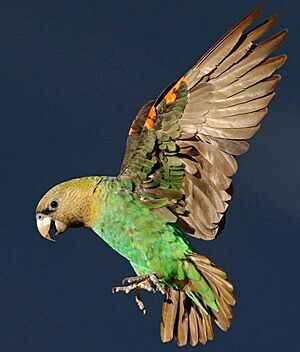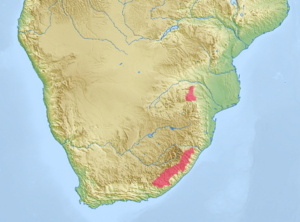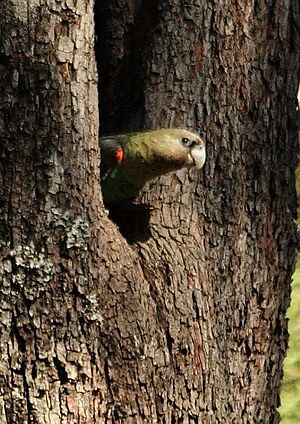Cape parrot facts for kids
Quick facts for kids Cape parrot |
|
|---|---|
 |
|
| Near East London, Eastern Cape | |
| Conservation status | |
| Scientific classification | |
| Genus: |
Poicephalus
|
| Species: |
robustus
|
 |
|
| P. robustus range | |
The Cape parrot (Poicephalus robustus) is a large, colorful parrot that lives only in South Africa. It prefers cool, misty forests. This parrot is also known as Levaillant's parrot.
For a long time, the Cape parrot was thought to be a type of brown-necked parrot. However, scientists now know it is a unique species. It is different from its relatives, the brown-necked parrot and the grey-headed parrot.
Contents
About the Cape Parrot
Scientists first described the Cape parrot in the late 1700s. A German naturalist named Johann Friedrich Gmelin gave it the scientific name Psittacus robustus in 1788. The word robustus means "strong" or "robust" in Latin. This name fits the parrot well because of its powerful beak.
Later, the Cape parrot was placed in a group of parrots called Poicephalus. The name Poicephalus comes from ancient Greek words meaning "grey" and "headed."
Scientists have studied the genes of these parrots. In 2015, they confirmed that Cape parrots are truly different from brown-necked parrots. They found that these two types of parrots separated millions of years ago. This happened during a time when forests and grasslands were changing a lot.
What Does a Cape Parrot Look Like?
The Cape parrot is a medium-large bird with a short tail. It has a very strong, large beak. This beak is perfect for cracking open hard nuts and fruit seeds. They especially love the seeds from African yellowwood trees.
Female Cape parrots often have a bright orange patch on their forehead. Young parrots also have a larger orange-pink patch on their forehead. However, young birds do not have the red feathers on their shoulders and legs that adult parrots do. The colors and patterns on their feathers can be a bit different from one parrot to another.
Where Do Cape Parrots Live?

Cape parrots live only in South Africa. They are found in special mountain forests called Afromontane forests. These forests are usually at medium heights, from near the coast up to about 1000 meters (3,300 feet) high.
These forests are not one big area. Instead, they are small patches spread across southern and eastern South Africa. They are full of tall yellowwood trees. Cape parrots depend on these trees for food.
The largest group of Cape parrots lives in the Amathole Mountains in the Eastern Cape province. Other smaller groups are found further east. A very tiny group of about 30 parrots lives far north in the Magoebaskloof area.
Cape parrots are not found in all Afromontane forests in South Africa. For example, they are not seen in forests near Knysna or in the high Drakensberg mountains.
Cape Parrots as Pets
More than a hundred Cape parrots are kept as pets. Most of these birds were caught in the wild. Even though they can breed in captivity, releasing them back into the wild has not worked well so far. This means that protecting their natural homes is very important for their survival.
It is against the law to trade or export wild-caught Cape parrots from South Africa. This is because of an international agreement called CITES. They are rare as pets, even though some illegal trade still happens. People who own them say they have great personalities. They can even learn to talk, much like their larger cousin, the grey parrot.
Protecting Cape Parrots
The Cape parrot is considered a vulnerable species. This means it faces a high risk of becoming endangered in the wild.
Every year, on the first weekend of May, hundreds of volunteers take part in the "Cape Parrot Big Birding Day." This is a special event where people count the parrots across all their habitats. It is fairly easy to count them because they have a unique shape when they fly. They also fly slowly and make loud calls.
Volunteers count the parrots in the evening as they fly to their roosting spots. They also count them in the morning as the parrots leave. It is hard to count every single parrot because their forests are spread out. Also, the birds fly long distances for food, so they might be counted more than once.
In 2000, about 500 Cape parrots were counted. In recent years, this number has grown to over 1000. This increase might be partly because more areas are being counted now.
Cape parrots face a serious threat from a disease called Psittacine beak and feather disease virus (BFDV). Some people think that eating a lot of yellowwood fruits might help parrots fight off this disease.
Their homes are also shrinking because of logging. Old yellowwood trees and dead trees with good nesting holes are being lost. Providing special nesting boxes has helped some parrots breed, which gives hope for increasing their numbers.


